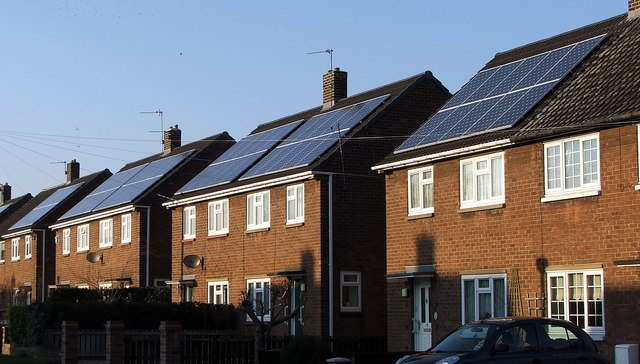Current Feed in Tariff Wind Energy Uk

The UK's feed in tariff (FiT) scheme for small-scale renewables will officially close on 31 March 2019, according to the Department of Business, Energy and Industrial Strategy (BEIS). Currently the FiT scheme pays domestic and commercial green energy producers for the electricity they generate and export to the grid. The closure follows the announcement in 2015, that new generation tariffs would be stopped in March 2019.

Wind Power Market seeing increased risk and disruption
The wind power market has grown at a CAGR of 14% between 2010 and 2021 to reach 830 GW by end of 2021. This has largely been possible due to favourable government policies that have provided incentives to the sector. This has led to an increase in the share of wind in the capacity mix, going from a miniscule 4% in 2010 to 10% in 2021. This is further set to rise to 15% by 2030. However, the recent commodity price increase has hit the sector hard, increasing risks for wind turbine manufacturers and project developers, and the Russia-Ukraine crisis has caused further price increase and supply chain disruption. In light of this, GlobalData has identified which countries are expected to add the majority of wind power capacity out to 2030. Get ahead and download this whitepaper for more details on the current state of the Wind Power Market.
by GlobalData
The move has been met by wide spread criticism from the renewables sector, which says it will cost jobs, investment opportunities and set the UKs transition to renewable power back. Greenpeace's chief scientist Doug Parr decried the move saying it "reveals another layer of the government's nuclear obsession that lacks economic or environmental merit, which will see the UK struggle to meet its climate targets, and leaving our reputation for leadership on tackling climate change in tatters."
BEIS said that the closure will allow the government to develop a system that takes into account the growth of technologies such as batteries and the changing energy landscape. It will also save an average of £1 a year per British household according to the impact assessment. However, this will do little to alleviate the lost export value of those who have already purchased solar panels.
"It is pleasing to hear positive words about renewables from the Government, but this has to be backed up by good deeds," said the Renewable Energy Associations head of policy & external affairs James Court. "While nobody in the industry was expecting an 11th hour reprieve for the Feed-in Tariff, the removal of the 'export tariff' for new projects will lead to the truly bizarre situation where consumers who own technologies such as solar will give electricity they don't consume to the grid for free."
Since it's creation in 2011, the FiT scheme has encouraged vast growth of solar uptake in the UK, and many see as one of the key drivers to its success. "Feed-In Tariffs have enabled around 800,000 households and 28,000 businesses to generate their own clean solar power to date, transforming the future of energy in the UK," said solar trade associations CEO Chris Hewett. "Last week 10% of all UK electricity was generated by solar. This would simply not have happened without the Feed-in-Tariff."
Post-subsidy Britain
What will follow on from the FiT scheme is uncertain, and the government has launched a call for evidence for potential new policies for small scale renewables. "In publishing this call for evidence, I want to understand what the opportunities and challenges are for the sector; to give them the opportunity to demonstrate the options available to provide benefits to the electricity system and UK consumers; and to build a strong consensus for action," said Claire Perry, Energy and Clean Growth Minister in the foreword of The Future For Smallscale Low-Carbon Generation: A Call For Evidence.
The call for evidence has itself drawn criticisms from renewables groups however, many of whom think it comes too late. "Today's confirmation that there will be no replacement for the Feed-in Tariff is a major blow to small-scale renewables in the UK," said RenewableUK's executive director Emma Pinchbeck. "The Government has known the FiT would be closing for three years and the fact that they are only now beginning the conversation about new policies is far too little, far too late for many companies.
Optimism does remain for the future of small-scale renewables in the UK particularly solar power. This is predominantly dues to the huge cost reductions seen in recent year, meaning the cost of solar has dropped by 90% since 2010.
"The good news, as we look beyond FITs, is that solar is coming of age and while solar always makes great environmental sense it now makes economic sense for most investors without public subsidies given fair treatment by government. An average domestic solar system cost £12,000 in 2010. It is more like £5,000 today."
The closure of FiT will undoubtedly bring a host of challenges, slowing the industry in the UK and increasing the difficulty of hitting our climate targets.
"Post-subsidy could be a reality, but in an energy market where nothing, not even gas power stations, can be built without government support, it is unrealistic to expect consumers, businesses or developers to continue installing small scale generation," said Court. "This could be achieved by tax incentives, market enablers, and planning or building regulations, but we are currently left in an unnecessary policy vacuum without any firm proposals put forward by Government.
"This is all having an effect in the real world, with jobs, deployment and investment in solar now down to below 2012 levels, as shown by our annual report, REview."

Wind Power Market seeing increased risk and disruption
The wind power market has grown at a CAGR of 14% between 2010 and 2021 to reach 830 GW by end of 2021. This has largely been possible due to favourable government policies that have provided incentives to the sector. This has led to an increase in the share of wind in the capacity mix, going from a miniscule 4% in 2010 to 10% in 2021. This is further set to rise to 15% by 2030. However, the recent commodity price increase has hit the sector hard, increasing risks for wind turbine manufacturers and project developers, and the Russia-Ukraine crisis has caused further price increase and supply chain disruption. In light of this, GlobalData has identified which countries are expected to add the majority of wind power capacity out to 2030. Get ahead and download this whitepaper for more details on the current state of the Wind Power Market.
by GlobalData
Source: https://www.power-technology.com/analysis/end-feed-tariffs-uk-mean-small-scale-renewables/


